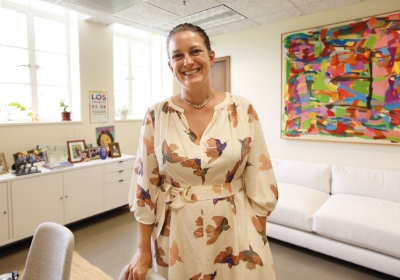Every morning, Jenna Garcia rises around 5 a.m. to get ready for work as a middle school science teacher. The married mother of three children, ages 5, 3 and 2, has about an hour to herself before she wakes up her kids, gets them dressed and fed and prepares their backpacks, water bottles and any other items they may need before heading to the car to go to daycare.
Depending on traffic, the trip from Garcia’s home in Corona to the childcare center takes about 15 minutes, with an additional 30 minutes to take each of her kids to their classrooms and get them settled. All told, the drop-off adds nearly an hour to what would otherwise be a 20-minute commute — all before her workday begins.
“At this point, we have it down to a really good science,” she said. “My kids know exactly what to do.”
Although transportation may not be the most important consideration when choosing childcare, it is central to the parents of the approximately 8 million children enrolled in center-based care nationwide.
“There is a body of literature that shows that kids really influence people’s travel patterns, in particular women’s travel patterns,” said Evelyn Blumenberg, a UCLA professor of urban planning and director of the Lewis Center for Regional Policy Studies. “There’s not that much that’s known about it, in part because there’s no great data sources out there to look at childcare travel.”
Transportation scholarship is largely focused on a single destination, predicated on the notion that commuters travel directly from home to work and back. But more than a quarter of all travel involves making a stop on the way to or from work. And, Blumenberg said, nearly 70 percent of working women experience these “trip-chain” commutes.
“For most people — and particularly for women, and women with children — it’s not a straight beeline from home to work,” she said. “Men do it too, but women are more likely to do it. Women are stringing together trips and doing household-supporting travel, one purpose of which is to drop kids off at childcare or schools.”
The relationship between childcare and transportation has become more pronounced, with 23.5 million mothers with children under the age of 18 in the workforce today, according to the U.S. Census Bureau. Studies have shown that the unpredictability of commute time is a source of worry and stress for parents, whose considerable hours at work coupled with long commutes mean less time with their children. Long travel times — to childcare centers and then to work — also may constrain women’s employment choices and potentially limit their labor force participation.
For parents like Garcia, whose husband has work hours opposite her own, the trip-chain travel time means she often extends her workday, staying late to prepare for the next day’s classes before picking up her children. This allows her to have more quality time with her kids in the evening while her husband is at work.
“It’s definitely a well-oiled machine,” she said, “and if it breaks down, we all feel the stress of something not happening right.”
Childcare and commuting
Blumenberg, UCLA data scientist Zhiyuan Yao and graduate student Madeline Wander studied access to childcare and childcare travel, using California-specific “add-on” data from the 2017 National Household Travel Survey, which gather information on travel and transportation patterns, along with confidential data from the California Department of Social Services on licensed daycare centers open between 2010 and 2020.
The researchers were interested in the relationship between the availability of childcare centers and the likelihood that a family with children under age 5 would take advantage of formal daycare. They also studied the question of how the proximity of available childcare affects travel.
The NHTS data included geographic information on where respondents lived, worked and where they traveled to on a single day, in addition to general demographic information. “They wrote in, ‘I traveled to a childcare center’ or ‘to my kids’ school,’” Blumenberg said. “And the survey had a latitude and longitude associated with where they went.”
The greatest challenge for the researchers was the painstaking process of matching this travel behavior data from the NHTS with the geographic location of the licensed childcare centers. Once they had that information, they could determine travel distances and trip-chain stops for childcare.
The clearest conclusion was that childcare demands weigh more heavily on women. Women were more likely than men to be responsible for escorting their children to childcare, regardless of the number of household workers, household income, race/ethnicity or educational attainment.
Beyond that, the study also demonstrated that childcare and transit are interrelated. The researchers found that most parents enroll in childcare centers within four miles of their house, with a median drive time of about 10 minutes. “That’s not to say that there aren’t some people who travel longer,” Blumenberg said. “Clearly our study shows that if there’s not enough daycare located close by, you’re going to travel farther.”
Among households with at least one worker, families tended to send their children to centers located closer to their homes than to their workplaces.
And like Garcia, most of the people in the survey traveled by car to take their kids to daycare. “About 90% of the trips in our dataset were by car; the rest were by walking,” Blumenberg said. “We did not have a single person who used public transit to drop their child off or pick them up from their childcare center.”
Predictably, then, for households without an automobile, formal childcare arrangements can be difficult. “It’s very, very challenging for them to have complex travel patterns,” she said, “so it’s likely forcing them to scramble to think about who’s caring for their kids.”
Access to childcare varies
The nonprofit Center for American Progress reports that 51 percent of people in the United States live in a “childcare desert,” which is a Census tract with more than 50 children under age 5 that contains either no childcare providers or so few options that there are more than three times as many children as licensed childcare slots. In California, that figure is 60 percent overall, with 72 percent in low-income neighborhoods.
Not surprisingly, access to licensed childcare is best in high-income urban neighborhoods with concentrations of well-educated professionals and is sparse in rural areas. Blumenberg and her colleagues also found formal childcare centers in short supply in newer suburban areas as well as heavily Hispanic areas. Childcare options further dwindled, the researchers found, during the COVID-19 pandemic, when many centers closed due to low enrollment, high costs and staffing shortages.
According to Blumenberg’s study, about 50 percent of young children nationwide receive care from non-parents. Of that group, 62 percent — or about 8 million children — are enrolled in formal center-based care. “We really do need to be thinking about the supply of childcare,” Blumenberg said. “Who has access to childcare — and hopefully affordable childcare.”
Latino households with young children had the lowest access to childcare of any race/ethnicity, their study found. Latino households make up nearly 39% of households with young children in California, but less than one-third of those use formal care.
“In largely Hispanic neighborhoods, maybe there’s less demand; maybe they prefer a family member to take care of their kids,” Bloomberg said. “Larger literature suggests that may be true, but there’s still limited supply, because if you provide more care in those neighborhoods, including subsidized care, then you tend to get higher rates of use.”
The federal government provides funding and services for children from low-income households through programs like Head Start or Child Care and Development Block Grants. California’s Head Start program is the largest in the nation. These subsidies help improve access in areas where there are fewer formal childcare centers.
“We had speculated that we would see more disparities by income and race,” Blumenberg said, “but subsidized care tends to fill in in some of those neighborhoods.”
But even though families in some low-income neighborhoods may have reasonable access to childcare, studies find that their care options tend to be of lesser quality than in higher-income areas.
AS PARENTS WITH OPPOSITE WORKING schedules, Garcia and her husband had specific requirements that made their choice more challenging.
“We would need childcare earlier than most people would offer, or they would need to be picked up sooner than we were capable of it,” she said. “It really limited who or where we were able to put our kids.”
They had few options in her immediate neighborhood — particularly since they hoped to have all three children in the same facility.
“One of the things I’ve always struggled with when it comes to childcare is availability,” Garcia said. “I’ll get a recommendation for somebody, but then they don’t have a spot available for my kids or the number of kids or the age. I know a lot of parents’ experience when it comes to childcare is: Are they available and can they afford it?”
Overall, the researchers suggest the need for additional enhanced assistance not just for families but also for childcare businesses. These subsidies could help improve access to childcare services and would help maintain an adequate supply of such centers, particularly in non-urban areas.
Changes in transportation policy could help improve childcare access in rural or suburban neighborhoods. “It’s much more difficult to provide services in a dispersed area,” Blumenberg said. “Transit doesn’t work very well in outlying suburbs because it takes too long to get places. In some ways, that’s the same dilemma in some of these outlying suburban areas where the people are dispersed. The childcare centers are dispersed. It takes a long time to get to them — and that can serve as a real barrier.”
Subsidized auto ownership, car-sharing programs and other enhancements are being tested in rural and non-urban parts of California.
It’s tough for women trying to handle complex travel while managing a job and trying to meet the needs of their kids, Blumenberg said. “Despite the growth in female labor force participation rates, there’s still a very gendered division of labor,” she said. “With the travel related to childcare and other household-supporting functions, we really need to think about efforts to have an equitable division of household labor. That would certainly help women manage.”
Garcia says she often arranges her schedule around her children, picking them up around 5:30, then making dinner before settling into their “night routine.”
“Having kids in childcare, it’s a beast. It’s a whole thing — and it takes a village,” she said. “Any parent who has their kid in childcare understands the importance of a routine, and when that routine gets disrupted by sickness or work or a national pandemic, they usually have to pivot pretty quickly, and it can make things pretty stressful. But parents who have their kids in childcare know how to manage those situations because we have to. There’s no other option for us.”

























